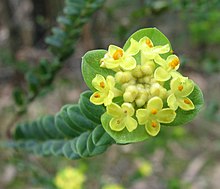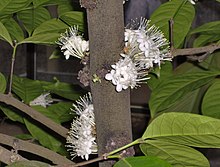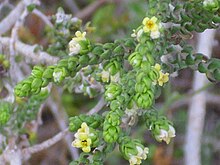Daphne family
| Daphne family | ||||||||||||
|---|---|---|---|---|---|---|---|---|---|---|---|---|

Rosemary Daphne ( Daphne cneorum ) |
||||||||||||
| Systematics | ||||||||||||
|
||||||||||||
| Scientific name | ||||||||||||
| Thymelaeaceae | ||||||||||||
| Yuss. |
The daphne plants or sparrow tongue plants (Thymelaeaceae) are a family in the order of the Mallow-like (Malvales). Your most famous plant species in Central Europe is the real daphne ( Daphne mezereum ). Some species are used as ornamental plants , for logging or for the production of incense.
description
Vegetative characteristics
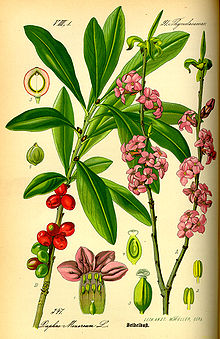
illustration in Otto Wilhelm Thomé : Flora of Germany, Austria and Switzerland , Gera 1885

They are mostly woody plants: trees or bushes , rarely lianas ; herbaceous plants are rarely found . They are evergreen or deciduous. Their very fibrous bark is typical of this family. In many species, the vegetative parts of the plant smell unpleasant.
The leaves are usually opposite, less often alternate or whorled . The ever simple and whole-edged leaves can be medium to small in size. In some species, they are also reduced in size , similar to the heather family (Ericaceae). The leaf nerves are usually arranged in parallel. In many species, the fallen leaves leave clear scars. Stipules are missing.
Generative characteristics
The flowers are solitary or usually in lateral or terminal, dense tufted, heady, racemose or panicle inflorescences together. Bracts are often present. Some species are kauliflor .
The radial symmetrical to slightly asymmetrical flowers are four or five-fold (rarely six-fold). In most species, the flowers are hermaphroditic. If the flowers are unisexual, then there are monoecious ( monoecious ) or dioecious ( dioecious ) separate-sexed species. A conspicuous flower cup (hypanthium) is almost always present, in Synandrodaphne it is more or less missing. The mostly hollow flower base is usually widened to form a so-called discus. The sepals are often fused together at the bottom to form a calyx tube. In some species the sepals are brightly colored and form the display apparatus of the flower, while the petals are scaled down and either sit at the entrance of the calyx tube or are completely absent. There are usually two circles with four or five stamens each, which are free from each other, but are fused with the calyx tube. But there can also be 11 to 35 stamens. In Pimelea there are only two fertile stamens. If there are two carpels , then one is greatly reduced, they have grown together to form a single ovary above. But there can also be three to five, rarely up to twelve carpels, which have grown together to form a two- to five-fold ovary.
The fruits are berries , loculicidal capsule fruits ( Aquilaria ), achenae-like nut fruits and stone fruits .
The basic number of chromosomes is usually x = 9 (rarely 7-10); Polyploidy is common.
ingredients
Many species are poisonous. They contain diterpene esters , cyclopropenoid fatty acids , chelidonic acid and myricetin .
distribution
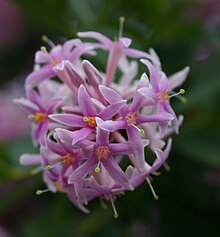





Representatives of the family occur worldwide from the temperate zones to the tropics, with the exception of Siberia , the Sahara and parts of North America . Particular areas of distribution are the subtropical areas of Australia and Africa , as well as the Asian steppes and the Mediterranean area . They are more diverse in the southern hemisphere .
Most species prefer dry, light-rich locations, for example in bushes or in dry forests.
Systematics
The Thymelaeaceae family was founded in 1789 under the name "Thymelaeae" by Antoine-Laurent de Jussieu in Genera Plantarum, secundum ordines naturales disposita juxta methodum in Horto Regio Parisiensi exaratam. , 76 first published. Sometimes the publication by Michel Adanson in Familles des plantes , 2, 1763, 278 is also cited. The type genus is Thymelaea Mill. And the second German family name also refers to the German common name Spatzenzungen of this genus. Synonyms for Thymelaeaceae Juss. are: Aquilariaceae R.Br. ex DC. , Daphnaceae Vent. , Gonystylaceae Tiegh. , Phaleriaceae Meisn. , Tepuianthaceae Maguire & Steyerm.
The family is divided into two subfamilies and one genus that is neither contained in one nor the other subfamily: Depending on the view, the family contains about 50 to 60 genera with 500 to 800 species:
- Subfamily Octolepoideae Gilg (Syn .: Gonystylaceae Tiegh. , Gonystyloideae Tiegh. ): With seven to eight genera and about 50 species:
-
Arnhemia Airy Shaw : With the only species:
- Arnhemia cryptantha Airy Shaw ; it occurs in Australia
-
Deltaria Steenis : With the only species:
- Deltaria brachyblastophora Steenis : The home is New Caledonia .
- Dicranolepis Planch. : With about 20 species in tropical Africa.
- Gonystylus Teijsm. & Binn. : With 20 to over 30 tree species from peat bog forests in Indonesia and Malaysia ; some are also called ramin.
- Lethedon Blast. : With around 15 species on New Caledonia , Vanuatu and Queensland .
- Octolepis Olive. : With six species only in Madagascar.
- Solmsia Baill. : With about two species in New Caledonia.
-
Arnhemia Airy Shaw : With the only species:
- Subfamily Thymelaeoideae Burnett : With 37 genera and about 690 to 750 species:
-
Aetoxylon (Airy Shaw) Airy Shaw : With the only kind:
- Aetoxylon sympetalum (Steenis & Domke) Airy Shaw : This tree species only occurs in the wild in western Sarawak .
-
Amyxa Tiegh. ex Domke : With only one species:
- Amyxa pluricornis (Radlk.) Domke ; it occurs on Borneo
- Agarwood trees ( Aquilaria Lam. ): With about 15 species in Bhutan , Cambodia , China , northeast India , Laos , Malaysia , Myanmar , Thailand and Vietnam . The wood of some species from Indo Malesia is used as incense, for example agarwood . This belongs here:
- Agarwood tree ( Aquilaria malaccensis Lam. , Syn .: Aquilaria agallocha Roxb. )
-
Breath nosiphon Leandri : With the only kind:
- Breath nosiphon coriaceus (Leandri) Leandri : The home is Madagascar .
- Craterosiphon Engl. & Gilg : With around nine species widespread in tropical Africa, mainly in the rainforest areas of Central and West Africa.
- Cryptadenia Meisn. (Is also put to Lachnaea by some authors): With about five species that occur in southern Africa
- Dais L .: With about 25 species in southern Africa and Madagascar . They are deciduous shrubs or trees with pompom-like inflorescences that are sometimes used as ornamental plants.
- Daphne ( Daphne L. ): With about 50 species in Eurasia and North Africa, including some ornamental plants , including Wikstroemia about 110 species.
- Daphnimorpha Nakai (also referred to by some authors as belonging to Wikstroemia ): With two types; the home is Japan.
-
Daphnopsis Mart. : With about 50 to 55 species in the Neotropic from central Mexico to southeastern Brazil and Argentina including the Caribbean islands. This includes the type:
- Daphnopsis bissei A.Noa : Few specimens of this extinct species have beenrediscoveredin the Cuban province of Camagüey .
- Diarthron Turcz. : With about 16 species in central and southwest Asia to southeast Europe (the European part of Russia and western Kazakhstan).
- Dirca L .: With three kinds in North America.
-
Draped lam. : With the only kind:
- Drapetes muscosus Lam. ; it occurs on Tierra del Fuego and the Falkland Islands
- Edgeworthia Meisn. : With about five species, four of them in China. One kind is common as an ornamental shrub. So-called rice paper is made from the bast fibers of a different kind.
- Enkleia handle. : With about four climbing species in Southeast Asia.
- Eriosolena flower (sometimes in Daphne L. ): With only two species in Cambodia, China, India, Indonesia , Malaysia, Myanmar, Thailand and Vietnam.
- Funifera Leandro ex CAMey. : With 3–4 species in Brazil
- Gnidia L. (including Lasiosiphon Fresen. ), With 140 to 150 species mainly in Africa, including Madagascar.
-
Goodallia Benth. : With the only kind:
- Goodallia guianensis Benth. ; it occurs in Guyana
- Agarwood trees or agarwood trees ( Gyrinops Gaertn. ): With about nine species in Sri Lanka, Laos and Malesia
-
Jedda J.R. Clarkson : With the only kind:
- Jedda multicaulis J.R. Clarkson : The homeland is northwestern Australia.
- Kelleria Endl. (sometimes in Drapetes Lam. ): With five species on Borneo , New Guinea , New Zealand and Australia . They are low bushes.
- Lachnaea L .: With about 40 species and two subspecies only in the Capensis .
- Lagetta Juss. : With about three species in the Caribbean
- Lasiadenia Benth. : With two kinds in the Neotropic.
- Linodendron Griseb. : With about four species in Cuba.
- Linostoma Wall. ex Endl. : With about three types; they occur from Indomalesien to tropical Australia
- Lophostoma (Meisn.) Meisn. : With about four species in tropical South America
-
Oreodendron C.T.White : With the only species:
- Oreodendron biflorum C.T.White ; it occurs in Queensland
- Ovidia Meisn. : With two kinds; they occur in South America
- Passerina L .: With around 15 species in the Capensis, one species extends to Angola and Zimbabwe .
- Peddiea Harv. ex Hook. : With about ten species in tropical and southeastern Africa and Peddiea involucrata Baker in Madagascar.
- Phaleria Jack : With around 20 species, 20 in Malesia , Pacific Islands and Australia (four species).
- Shiny shrubs ( Pimelea Banks ex Gaertn. ): With around 110 species from Asia, New Zealand and Australia, some of which are sometimes planted as ornamental shrubs.
- Rhamnoneuron Gilg (sometimes in Daphne L. ): With only two shrub species in China and Vietnam.
- Schoenobiblus Mart. : With about eight species. These shrubs thrive in the middle altitudes of the northern Andes .
- Stellera L .: With ten to twelve species in central and eastern Asia.
- Stephanodaphne Baill. : With seven to eight species only in Madagascar and the Comoros .
- Struthiola L .: With about 30 species mainly in the Capensis, three or four species in eastern and south-eastern tropical Africa. There are shrubs and ericoid dwarf shrubs.
-
Synandrodaphne Gilg : With only one species:
- Synandrodaphne paradoxa Gilg ; it occurs in tropical West Africa
- Synaptolepis olive. : With four or five species from tropical to southern Africa and Synaptolepis perrieri Leandri in Madagascar.
- Thecanthes Wikstr. (sometimes in Pimelea Banks ex Gaertn. ): With about four species; they occur in Australia
-
Sparrow tongues ( Thymelaea Mill. ): With 20 to 30 species, native to Central, Eastern and Southern Europe, North Africa, and Central and Southwestern Asia. Particularly in southern Australia and North America, individual species are also neophytes . This genus includes:
- Sparrow's tongue ( Thymelaea passerina (L.) Cosson & Germ. )
- Hairy sparrow tongue ( Thymelaea hirsuta (L.) Endl. )
- Wikstroemia Endl. : With about 70 species in eastern Asia, Malaysia, Australia and on the Pacific islands. Hawaii isa smaller center of biodiversity, where many species are diocesan. 49 species occur in China, 43 of them only there.
-
Aetoxylon (Airy Shaw) Airy Shaw : With the only kind:
-
Incertae sedis :
- Tepuianthus Maguire & Steyerm. (Some authors have their own family Tepuianthaceae Maguire & Steyerm. ): With seven species, there are trees or bushes thatare nativeto the Guiana Highlands, almost exclusively on the Tepuis . They have a bitter rind.
use
The bast fibers of many types (for example in Daphne , Edgeworthia , Thymelaea ) are very hard-wearing and are or were used to make ropes or paper.
Many tree species in this family have aromatic, hard wood . Some are used for building, others are used for smoking or as fragrances for incense. Species from several genera of this family are called agarwood trees (for example Aquilaria or Gyrinops ) or agarwood trees.
Some species in this family produce so-called "Gaharu" or "Agarwood" (for example in Aquilaria ). It often forms from the heartwood after injuries and probably also from fungal infections. "Gaharu" is very valued as a raw material for incense and medicine. Because of this use, some species have been decimated in their habitats.
Because of the often small, but pretty and fragrant flowers, some species (for example from Daphne , Dais , Dirca , Pimelea ) are used as ornamental plants .
swell
- Description of the family of Thymelaeaceae in APWebsite. (Section systematics and description)
- Yinzheng Wang, Michael G. Gilbert, Brian F. Mathew, Christopher Brickell & Lorin I. Nevling: Thymelaeaceae in der Flora of China , Volume 13, p. 213: Online. (Section description and systematics)
- Description in the Western Australian Flora. (Section description)
- Alfredo Noa Monzón: Thymelaeaceae in Flora de Cuba , Series A, Pl. Vasc. 15 (13), 2009, pp. 1-39.
- Entry in the flora of Madagascar. (engl.)
- GJ Harden: Thymelaeaceae at the New South Wales Flora Online . (Section description and systematics)
- B. Peterson: Thymelaeaceae : in Flora Zambesiaca , Volume 9, 2006.
- David John Mabberley: Mabberley's Plant-Book. A portable dictionary of plants, their classification and uses . 3rd ed. Cambridge University Press 2008. ISBN 978-0-521-82071-4
Individual evidence
- ^ A b Thymelaeaceae in Germplasm Resources Information Network (GRIN), USDA , ARS , National Genetic Resources Program. National Germplasm Resources Laboratory, Beltsville, Maryland.
- ↑ Thymelaeaceae - The trees in the Andes of Ecuador. (span.)
- ↑ Josephine Bertha Pauline Beyers (Doctoral Thesis): A taxonomic revision of Lachnaea L. (Thymelaeaceae) , University of Pretoria, 2000: The first nine pages as PDF online.
- ↑ Description of the family of Thymelaeaceae in APWebsite.
